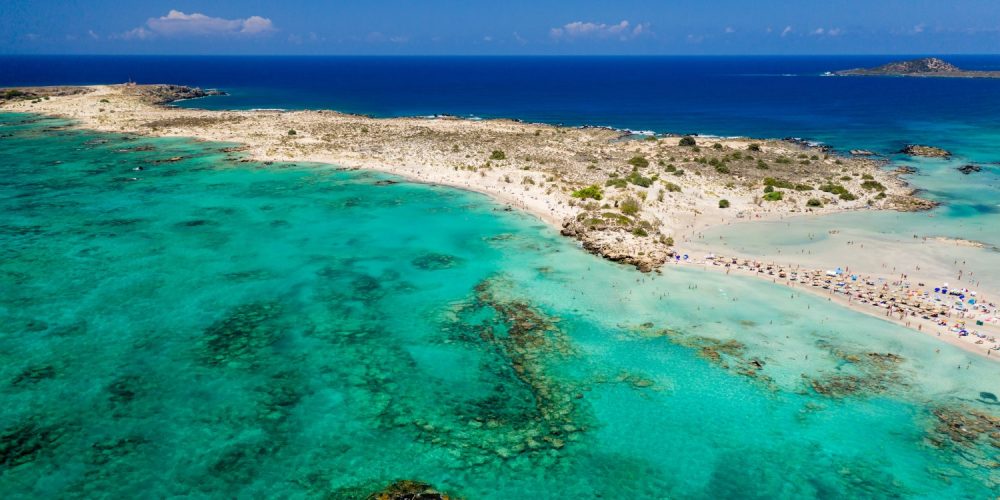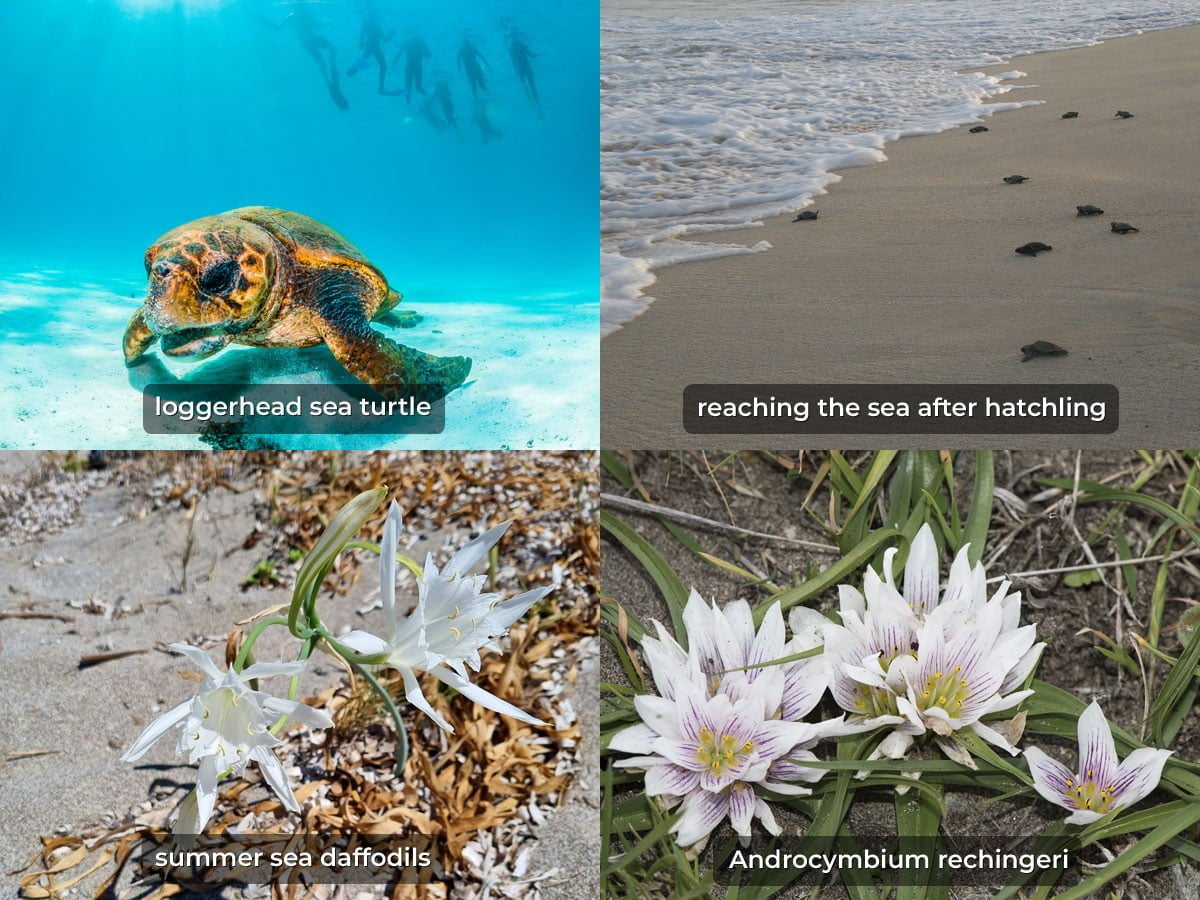
Elafonisi is a small island off the southwest coast of Crete. It is known for its pink sand beaches, its crystal clear waters, its rare flora and fauna, and its rich history. We will answer some of the most common questions about Elafonisi and give you some tips on how to make the most of your visit.
Elafonisi is not a very large island. It has an area of about 1.5 square kilometers (0.58 square miles) and a length of about 1.6 kilometers (1 mile). It is connected to the mainland of Crete by a sandbar that is submerged under about one meter (3 feet) of water at most during high tide. This means that you can walk to the island from the beach when the weather is fine.
Elafonisi is uninhabited by humans, but it is home to more than 100 rare plants and animals. Some of the most notable species are the loggerhead sea turtles, which use the beach as a nesting site, the summer sea daffodils, which bloom in white cups surrounded by spiky white petals, and the Androcymbium rechingeri, a winter-flowering bulb that is found nowhere else in the world. Elafonisi is a protected nature reserve and visitors are asked to respect the environment and follow the designated paths.

Elafonisi Flora & Fauna
There are no cities or villages on Elafonisi, but there are some nearby places where you can find accommodation, food, and other services.
The closest town is Chrysoskalitissa, which is about 5 kilometers (3 miles) away from the beach. Here you can find a monastery dedicated to the Virgin Mary that dates back to the 17th century. The monastery is built on a rock that has 98 steps leading to it. According to legend, one of the steps is made of gold, but only those who are pure of heart can see it.
Another option is to stay in Kissamos, which is about 40 kilometers (25 miles) away from Elafonisi. Kissamos is a seaside town that offers a variety of accommodation options, restaurants, shops, and cultural attractions.
You can also visit some of the nearby beaches, such as Balos and Falassarna.
**Where is Elafonisi located?**
Elafonisi is located in the municipality of Kissamos, in the regional unit of Chania, on the island of Crete. Crete is the largest and most populous of the Greek islands, and it is divided into four regional units: Chania, Rethymno, Heraklion, and Lasithi. Chania is the westernmost regional unit and it covers an area of 2,376 square kilometers (917 square miles). It has a population of about 156,000 people and its capital city is Chania.
**How to get to Elafonisi?**
There are several ways to get to Elafonisi from different parts of Crete. The most common ones are:
– By car: You can drive to Elafonisi from Chania or Kissamos by following the road E65 and then taking the exit for Paleochora/Elafonisi. The road is scenic but also winding and narrow in some parts, so be careful and allow enough time for your journey. The distance from Chania to Elafonisi is about 75 kilometers (47 miles) and it takes about 1 hour and 45 minutes to drive. The distance from Kissamos to Elafonisi is about 40 kilometers (25 miles) and it takes about 1 hour to drive.
– By bus: You can take a bus from Chania or Kissamos to Elafonisi. The buses run daily during the summer season (from May to October) and less frequently during the rest of the year. The bus fare from Chania to Elafonisi is about 8 euros per person and it takes about 2 hours and 15 minutes to get there. The bus fare from Kissamos to Elafonisi is about 4 euros per person and it takes about 1 hour and 15 minutes to get there.
– By boat: You can also take a boat from Paleochora or Sougia to Elafonisi. Paleochora and Sougia are two coastal towns that are located on the south side of Crete, opposite to Elafonisi. The boats run daily during the summer season and less frequently during the rest of the year. The boat fare from Paleochora to Elafonisi is about 10 euros per person and it takes about 1 hour to get there. The boat fare from Sougia to Elafonisi is about 15 euros per person and it takes about 1 hour and 30 minutes to get there.
**What are the touristic attractions on Elafonisi?**
The main attraction on Elafonisi is, of course, the beach. The beach is divided into two parts: the mainland beach and the island beach. The mainland beach is where most of the visitors go, as it has more facilities, such as sunbeds, umbrellas, showers, toilets, changing rooms, lifeguards, and a snack bar. The island beach is more secluded and natural, but it has no facilities, so you need to bring your own supplies.
The beach is famous for its pink sand, which is created by the crushed shells of a microorganism called Foraminifera. The pink color is more visible in some parts of the beach than others, and it depends on the weather conditions and the season. The best time to see the pink sand is in the morning or in the evening, when the sun is low and the light is soft.
The water on the beach is shallow, warm, and calm, making it ideal for swimming, snorkeling, and paddling. You can also enjoy some water sports, such as windsurfing, kitesurfing, stand-up paddle boarding, and kayaking. You can rent equipment from some of the local operators or bring your own.
Another attraction on Elafonisi is the island itself, which offers a different perspective of the beach and the surrounding landscape. You can explore the island by following the marked trails that lead you to various points of interest, such as:
– The plaque that commemorates the massacre of hundreds of Greeks by Ottoman soldiers in 1824. This tragic event happened on Easter Sunday, when a group of refugees from Crete and other parts of Greece were hiding on the island, waiting for a ship to take them to safety. The Ottoman soldiers spotted them and killed most of them or sold them into slavery.
– The wooden cross that marks the shipwreck of the Imperatrix in 1907. The Imperatrix was a passenger steamer that was sailing from Trieste to Alexandria when it hit a reef near Elafonisi during a storm. Thirty-eight people died in a lifeboat that tried to reach the shore and they were buried on the island. The wreck of the Imperatrix still lies on the seabed in front of the island’s cliffs.
– The lighthouse that was built on a hilltop on the island in 1909. The lighthouse was meant to prevent further shipwrecks like the one of the Imperatrix, but it was destroyed by German troops during World War II. Only some ruins remain today.
**How much does it cost to visit Elafonisi?**
Visiting Elafonisi does not have a fixed cost, as it depends on how you get there and what you do there. However, here are some approximate prices for some of the common expenses:
– Parking: There is a large parking lot near the beach that charges 2 euros per car per day.
– Sunbeds and umbrellas: There are several operators that rent sunbeds and umbrellas on the beach. The price varies depending on the location and the season, but it is usually around 10 euros for two sunbeds and one umbrella per day.
– Snacks and drinks: There is a snack bar on the beach that sells sandwiches, salads, ice creams, soft drinks, water, coffee, and beer. The prices are reasonable for a tourist spot, but you can also bring your own food and drinks if you prefer.
– Water sports: There are several operators that offer water sports activities on the beach. The price depends on the type and duration of the activity, but it is usually around 20 euros per person per hour for windsurfing or kitesurfing lessons or rentals, 15 euros per person per hour for stand-up paddle boarding or kayaking rentals, and 10 euros per person per hour for snorkeling equipment rentals.
Leave a Reply